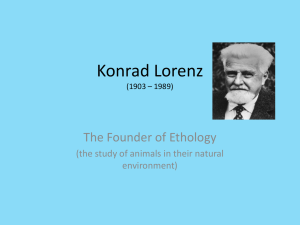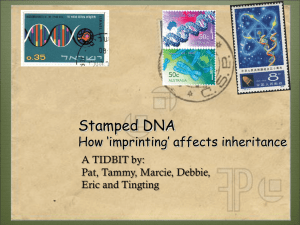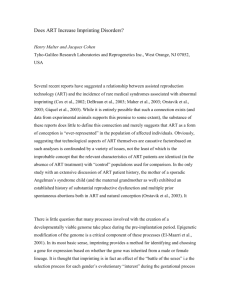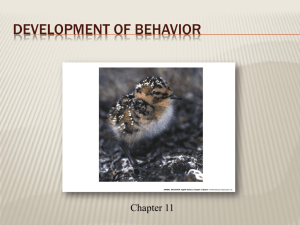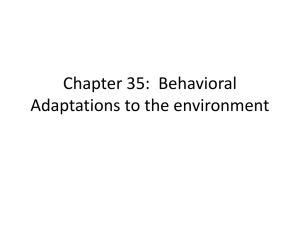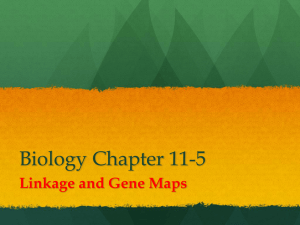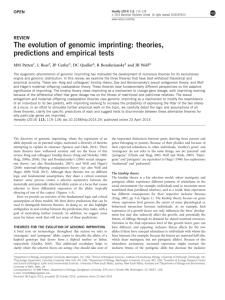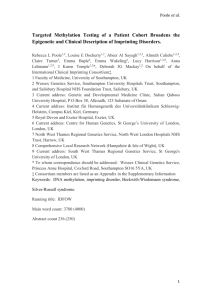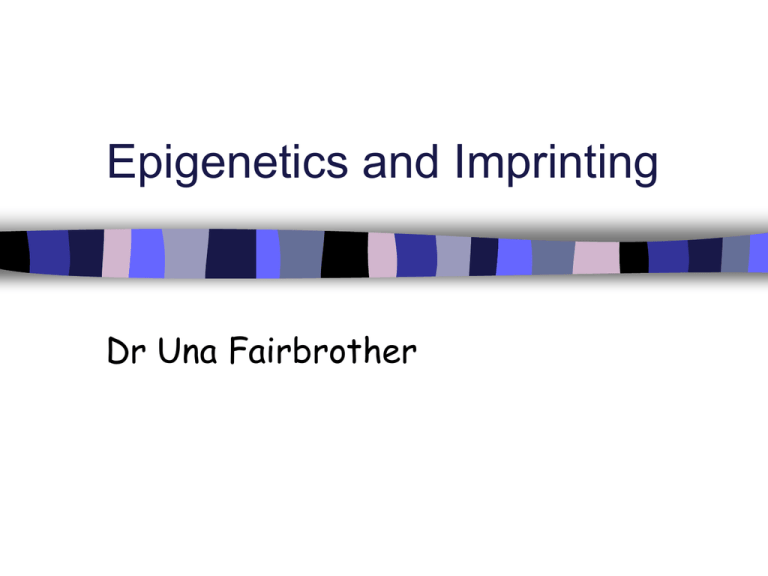
Epigenetics and Imprinting
Dr Una Fairbrother
Imprinting
Describes the differential expression
of genetic material at
chromosomal/allelic level, depending
on that material being maternal or
paternal in origin.
What is the imprint at a
molecular level?
An imprint is an heritable tag
Usually associated with
differential DNA methylation
The met CpG usually on the silent
chromosome
In addition, histone aceylation
and methylation has been
identified
Imprinting involves 3 distinct
biological stages
(a)
Establishment of the imprint
in gametes, according to the
sex of the individual
(b) Its maintenance during
embryogenesis/adult somatic
tissues
(c) Erasure in the early
germline
Schematic of Imprinting
Why imprinting?
The advantages of biparental
inheritance seem clear from
the recessive nature of many
disease mutations.
Imprinting could help to
maintain sexual reproduction.
Imprinting in Development
In mammals, imprinted genes have a
vital role in development of the
embryo and neonate.
The division is not clear cut but;
placental development appears to
rely more heavily on paternal
expression
embryonic growth appears to rely
more heavily on maternal
expression.
Imprinted Genes Present a
complex Picture Of
Expression
In embryonic development,
monoallelic expression is not
always coincident with the
onset of gene expression
Can vary with development and
differentiation.
Imprinting, primary
inactivation?
Some evidence suggests that
the imprint itself does not have
to be a primary inactivation
event
The imprinting mechanism may
involve additional trans-acting
molecules.
Imprinting and Disease
Approx 80 imprinted genes in the human
genome poss up to 600!
Non-mendelian inheritance pattern with
parent of origin effects
Best characterised syndromes:
Angelman/Prader-Willi syndromes on 15q
(UBE3A- AS)
Beckwith-Wiedemann syndrome (BWS) 11p
(IGF2)
Species
Human
Human
Human
Human
Human
Human
Human
Human
Human
Human
Human
Human
Human
Human
Human
Human
Human
Human
Human
Human
Human
Human
Human
Human
Human
Human
Human
Chr
01
01
06
06
06
07
07
07
07
07
07
07
11
11
11
11
11
11
11
11
11
11
11
11
11
11
11
Gene
ARHI, NOEY2
TP73
PLAGL1; ZAC; LOT1
HYMAI
IGF2R, M6PR (disputed)
GRB10, MEG1
PEG10
DLX5
MEST, PEG1, MESTIT1, PEG1AS COPG2 (disputed
PEG1-AS, MESTIT1
CPA4
WT1 (disputed)
H19
IGF2
IGF2AS, PEG8
INS, insulin
TRPM5, LTRPC5, MTR1
KCNQ1, KvLQT1
KCNQ1OT1, LIT1, KvLQT1-AS,
KvDMR1
KCNQ1DN, BWRT
CDKN1C, p57KIP2
SLC22A1L, IMPT1, BWR1A,
ORCTL2, ITM, TSSC3, IPL,
BWR1C, TSSC5, HET ,ZNF215
2G3-8
SDHD
Human
Human
14
14
15
Human
Human
Human
15
15
15
15
15
15
15
15
15
15
15
15
15
15
18
19
20
20
Human
Human
Human
Human
MEG3, GTL2
DLK1, PEG9
Paternally expressed noncoding transcripts on 15p
(Prader-Willi syndrome region)
MKRN3, ZNF127
NDN
MAGEL2, NDNL1
SNRPN, SNURF
PAR-SN
HBII-13
PAR5, D15S226E
HBII-85, PWCR1
IPW
PAR1, D15S227E
HBII-52
UBE3A, E6-AP, UBE3A-AS
ATP10A, ATP10C
Elongin A3
PEG3
NNAT, Neuronatin
GNAS1, Gs alpha, NESP55,
XLalpha s, GNAS-AS
Features Of Imprinted Genes
No direct sequence homology has been
found among imprinted genes.
Sequences carrying mat and pat gametic
imprints resemble CpG islands containing
GC rich regions of between 200 and
1500bp with a balanced CG:GC ratio.
Imprinted sequences contain or are closely
associated with a region of direct repeats
ranging in size between 25 and 120bp.
They are found in all imprinted genes
analysed so far and are evolutionarily
conserved.
Imprinting Clusters
Imprinted genes are clustered
Best understood on chromosome 15 and 11
Complex coordinated regulation based on
an imprinting centre (IC) or an imprinting
control element (ICE)
Coodinates in cis expression of
neighbouring genes in one domain
Action of Imprinting Centres
Allele discriminating action of imprinting
centres based on epigenetic modifications
of chromatin
Typically via methylation of cytosines
(DNA)and histone acetlylation and
methylation
Acetylation of histones associated with
transcriptionally active chromatin
Methylation of histones and DNA
associated with inactivation of
transcription
Imprinting and Transcription
Methylation and acetylation lead to allele
specific accessibility to transcriptional
machinery
And to DNA binding proteins acting as
enhancers or insulators
Setting and stability of imprinted gene
expression controlled by ICs with multiple
levels of DNA and chromatin modifications
More complexity: IGF2
IGF2 (chromosome 11) has been shown to
be imprinted very early on, in 8 cell
human embryos
recruits different promoters to confer
mono or biallelic expression at different
developmental stages.
….And KVLQT1
KVLQT1 (chromosome 11) has been
reported as having a number of
alternatively spliced transcripts
shows both mono and biallelic expression
patterns in different tissues
Important in identification of imprinted
genes associated with imprinted
disorders
Conservation
Obviously evolutionary conservation is a
good way to identify fundamentally
important genes and sequence motifs
A horse mare-donkey cross gives rise to
a mule but a donkey-stallion gives rise to
a hinny
The callipyge gene phenotype “beautiful
buttocks” is only expressed when
paternally inherited Hum Mol Genet
1998 7:No10 review
Imprinting in animal models
Once thought to be restricted to
mammals, genomic imprinting has been
documented in angiosperm plants
1970, zebrafish 1995, insects, and C.
elegans 2004
There may be genomic imprinting in
drosophila, but transgenes have shown
that imprinting switch regions act as
silencers in flies
In marsupials methylation on the X chr
preferentially inactivates paternal X
Mouse studies are one of the commonest
in the literature
Of Mice and Men
Mouse models have been helpful in
identifying the genes involved in
Prader-Willi and Angelman
syndrome
The PWS mouse model has a partial
maternal duplication of the region
of mouse chromosome 7 homologous
to human 15q11-13
The AS mouse model has a paternal
duplication for the same region
Imprinting in Mice Not
Identical
There are differences in
imprinting between mice and
humans
Imprinting of H19, Igf2,
p57kip2 and Snrpn is the same
IGF2R appears to be
monoallelic in mice and biallelic
in humans, though this may be
polymorphic
Imprinting on Human
Chromosome 15
IC regulates chromatin structure, DNA
methylation and gene expression in a 2Mb
region in 15q11-13
Mutations in IC cause chromosome to be
stuck as a single gender and not assume
the sex imprint of its ‘host’.
>7 imprinted transcripts in AS region,
paternally expressed
UBE3A is only coding transcript maternally
expressed
Angelman Syndrome (AS)
incidence of 1/20,000 live births
severe mental retardation
Lack of speech (commonly only a three to
six word vocabulary)
Ataxic gait
Hand flapping
Happy disposition including inappropriate
laughter
Diagnostic EEG
Others
Inheritance pattern of AS
AS gene expressed MATERNALLY
Chromosome 15 deletion in As
and PWS
Initially identified by the same
cytogenetic lesion i.e. the deletion of
15q11-13
Prader-Willi Syndrome (PWS)
Clinically distinct syndrome
frequency of about 1 in 25,000 and
probably the most common syndromal cause
of human obesity Clinical features
including:
Mild mental retardation
Obesity
Short stature
AS Oppositely Imprinted to PWS
How Does AS Arise?
AS caused by loss of function of a
gene/genes from the maternal chromosome
15q11-13
(ICH study) 60% AS patients have large
cytogenetic deletion
4% have uniparental disomy
4% have mutations in the imprinting centre
(IC)
5% remaining, screened for mutations in
the AS gene, UBE3A (E6AP) (50% familial,
10 sporadic)
AS Oppositely Imprinted to PWS
Recurrence risk
typical large deletions are de novo and are
expected to have less than 1% risk
paternal UPD, (no parental translocation),
less than 1%
transmission of a structurally or
functionally unbalanced chromosome
complement can lead to 15q11-q13 deletions
or to UPD and will result in case-specific
recurrence risks.
no large deletion or UPD, probably 50% due
to maternal IC or UBE3A mutation see
overhead*
Risks confounded by mosaicism
UBE3A (E6AP) and AS
UBE3A (ubiquitin protein ligase) complex
expression patterns.
5’ end of gene alternatively spliced in a
variety of human tissue cell lines and in
human foetal tissues including brain
> 7 isoforms have been identified;
monoallelic expression is tissue specific
and isoform specific
Human fibroblast and lymphoblast tissues
and also adult mouse tissues show biallelic
expression.
Monoallelic expression of
UBE3A
Monoallelic expression of an isoform found
in mouse brain tissue
depression of expression is also evident in
the hippocampus of a paternal UPD mouse
Evidence for decrease of expression in
human brain
Clinical description of AS indicates a
developmental brain disorder and so
differential expression of the gene would
be expected in brain tissue.
UBE3A Has Even More
Complex Splicing
Normal UBE3A decreased in AS brain
(MATERNAL)
A new larger transcript decreased in
PW brain (PATERNAL)
Larger transcript is antisense and
spans half UBE3A with additional
down stream sequence
Also another sense strand was detected
which lies in between the 2nd and 3rd
polyadenylation signal of UBE3A
Imprinted and transcribed in the same way
as UBE3A
All other tissues antisense transcript not
expressed
The expression of the antisense transcript
in brain may force the UBE3A transcript
to be monoallelic in brain
Some as yet uncharacterised AS patients
could have a mutation in either the down
stream sense transcript or the antisense
transcript, see overhead*
Mouse models
Mouse models have been used to
identify imprinted regions by
engineering UPDs for mouse
chromosomes, in part or in full
Extensive mapping of imprinted
mouse genes and their human
homologues has been undertaken
http://www.mgu.har.mrc.ac.uk/impri
nting
Similarities to Human
Disease
AS mouse: Neuro behavoural
differences, mild ataxia, abnormal
limb clasping, hyperactivity,
diminished brain weight (10%
smaller)
The PWS mouse: increase in
postnatal loss, small skeleton,
grossly obese by 6 months
Differences to Human
disease
AS mouse no detection of language
difficulties (obviously), mouse also
showed gross obesity - could be
present in a subset of AS patients
as late onset
PWS mouse no detection of mild
mental retardation.
Usefulness of AS Mouse
Model
When gene was identified, AS
mouse brains could be looked at
and a monoallelically expressed
transcript of UBE3A was found
to be decreased as compared to
the normal and the PWS mouse
Outstanding questions
How and when during germline development are old
imprints removed and new ones introduced?
Which demethylating activities and chromatin
factors are involved?
How does the spreading of epigenetic information
in clusters work, - germline-specific, postzygotic
phenomenon or both?
How are imprints maintained when there is
genome-wide active and passive demethylation in
the early embryo?
How many fundamentally different arrangements
of imprinted genes and imprinting control elements
are there in the genome?
Cont…
How conserved is imprinting between mammalian
species?
How precisely do imprinted genes affect
extraembryonic and embryonic development, and
the nutritional exchange with the mother?
Are there interactions of imprinted genes
(particularly antagonistic ones) in known, or in
novel, physiological pathways?
In addition to growth and behaviour, are there
other developmental processes and mechanisms in
which imprinted genes have a decisive role, and
how will these fit with evolutionary theories?

